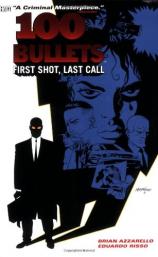100 Bullets, Vol. 1-13
Review
100 Bullets, Vol. 1-13
After a serial publication history spanning nearly 10 years, the final issue of 100 Bullets was published by Vertigo in April, followed in October by the final trade paperback collection, bringing an incredible, extended noir tale by writer Brian Azzarello and artist Eduardo Risso to an absolutely explosive conclusion. And while the ending wraps things up in grand fashion—and fans wouldn’t have it any other way—the real fun is in the journey.
One hundred issues for 100 Bullets seems like such perfect construction, and from the very begging, Azzarello’s story is smart. We are introduced in the very first issue to Dizzy Cordova, who goes on to play a bigger role in the series. Cordova’s family is murdered in Chicago. A mysterious man in a suit named Agent Graves approaches her and offers a way to avenge their deaths—an attaché briefcase with a handgun and 100 rounds of ammunition that by some method, initially unknown, have been rendered untraceable. Any police investigation that comes across the rounds will halt immediately. The case also includes indisputable evidence regarding the culprit. Essentially, it is a way to get away with murder, seemingly without consequences, and a nudge in the right direction.
Cordova’s initial short story wraps up in three issues, and then 100 Bullets moves onto a man wrongly sentenced in a child pornography case and the woman who set him up. As 100 Bullets progresses, we meet a full cast of characters who learn in their own short stories that there is someone to blame for the way their lives turned out. In each case, Graves offers the individual a way to rectify it with an attaché briefcase and 100 untraceable bullets. Some question the consequences of a higher power; some question the contents of the briefcase; some question their own accountability for where their lives are at; some simply take the opportunity to kill…and not always just the person responsible. No matter what, they all deal with the moral dilemma of that briefcase and their actions following it.
But as the stories unfold one after another, characters start to return as the reader learns that they are all connected by something more than the mysterious man and his attaché briefcases, and then a larger plot and conspiracy begins to unfold, keeping readers on the edge of their seats until the very last pages of chapter 13, “Wilt.”
The individual stories as well as the overall arc in 100 Bullets feel like good old-fashioned crime fiction, with beautiful, big-breasted blonde women, suave men in business suits carrying out some of the most violent action around, with everyone trying to stay one step ahead of the other in a plot that will keep readers thinking the entire time. But 100 Bullets also stays away from major clichés, and we also get women who, while, yes, are still almost universally big-breasted and beautiful, are such in a less traditional sense. Likewise, the guys are all cool in their own way, but each of them has a unique back story, leaving different reasons to both root for and despise them. The story finds a level of complexity unique to the storytelling in comics, and that’s what makes 100 Bullets truly special.
But arguably none of Azzarello’s story works without the art of Risso and his supporting staff. Risso’s management of designs for an incredible cast of characters is noted, but the real treat is how he handles perspectives, panel construction, focusing on small details and most notably his shadings of characters and shadow. This is accented by colorist Patricia Mulvihill. From the scenes bathed in sunset oranges to the nighttime blues and blacks, she possibly does the most in creating the true tone of 100 Bullets. And Dave Johnson doesn’t leave one cover in the entire series unmemorable.
Like most ongoing series, 100 Bullets has some rough edges at the very start, as Azzarello and Risso try to click and find their groove. The dialects Azzarello tries to recreate can be jarring at the beginning, but whether he gets better or the readers simply become accustomed to his incredible work along the way, it doesn’t take long for things to sink in, and then the story and the visuals grab hold. And unlike most other ongoing series, 100 Bullets never lets go. It’s hard to find a dull moment or an uninteresting character, dilemma, or story along the way, making100 Bullets a true testament to what can only be accomplished with collaboration in the comics medium. It is a pulp-driven extravaganza, striving for deeper meaning about the history of American violence. For the most part, 100 Bulletshits its mark, and like the crime saga greats of cinema, it is always entertaining.
Reviewed by William Jones on July 2, 2012
100 Bullets, Vol. 1-13
- Publication Date: February 1, 2000
- Genres: Graphic Novel
- Paperback: 128 pages
- Publisher: Vertigo
- ISBN-10: 1563896451
- ISBN-13: 9781563896453




